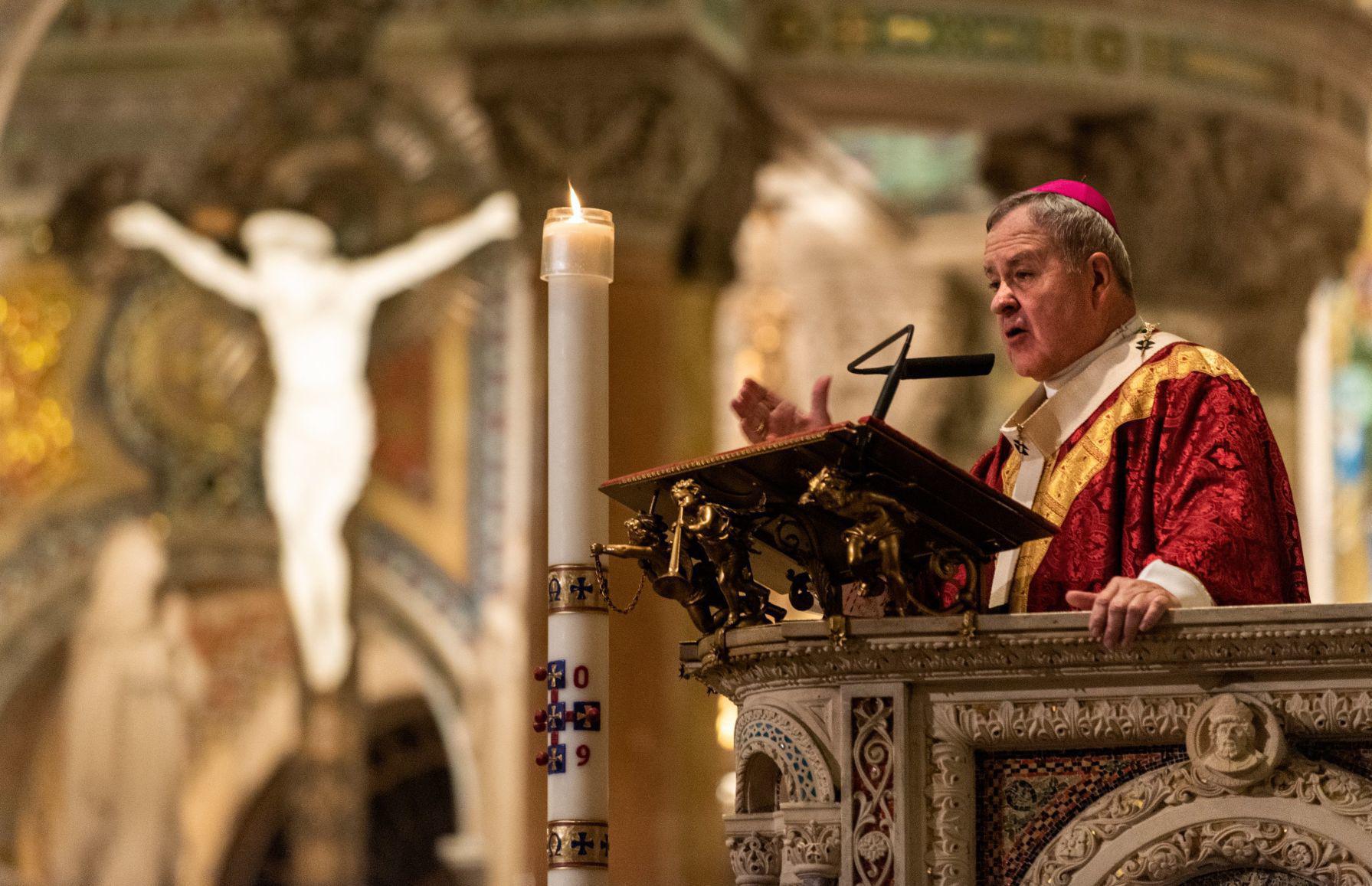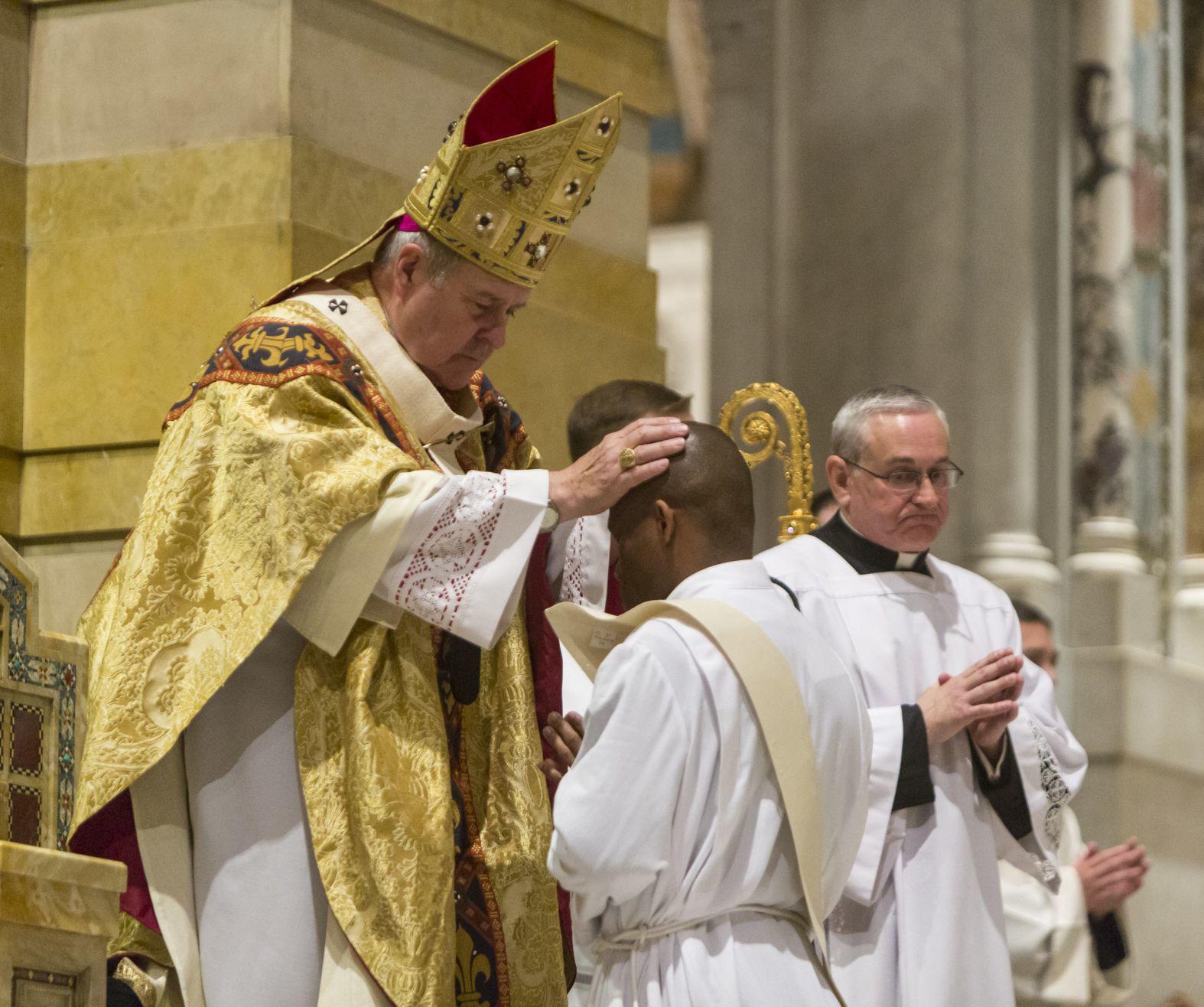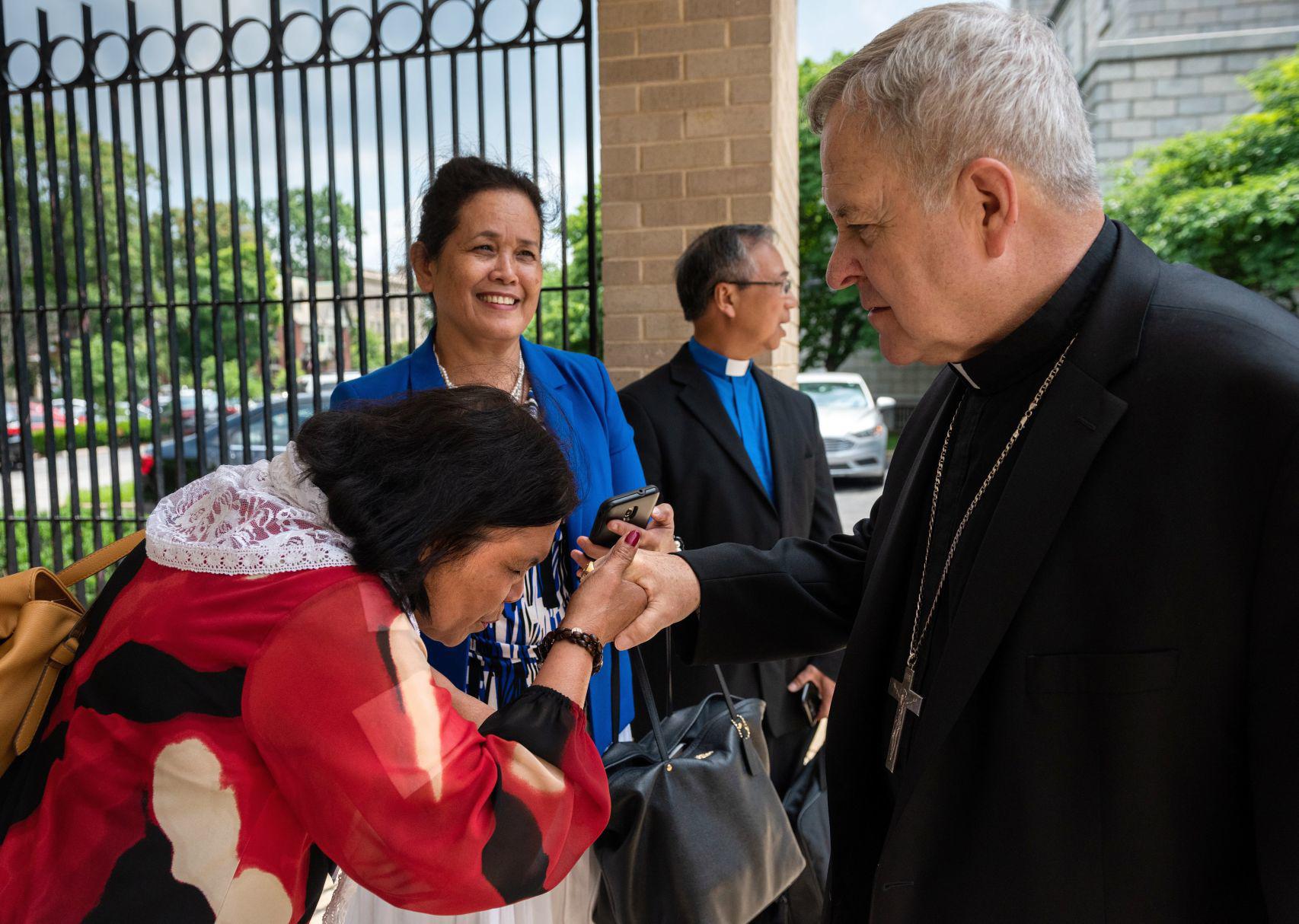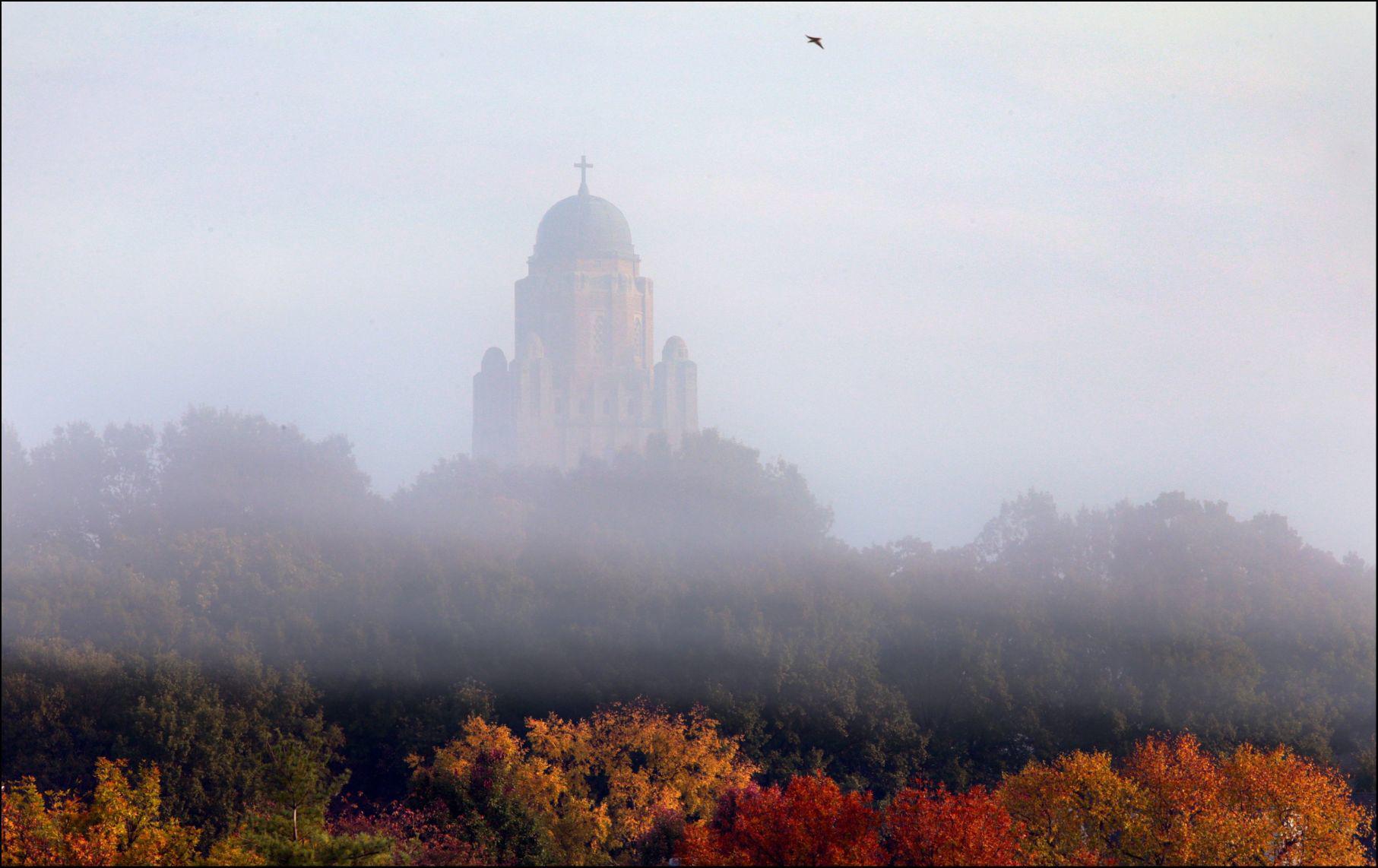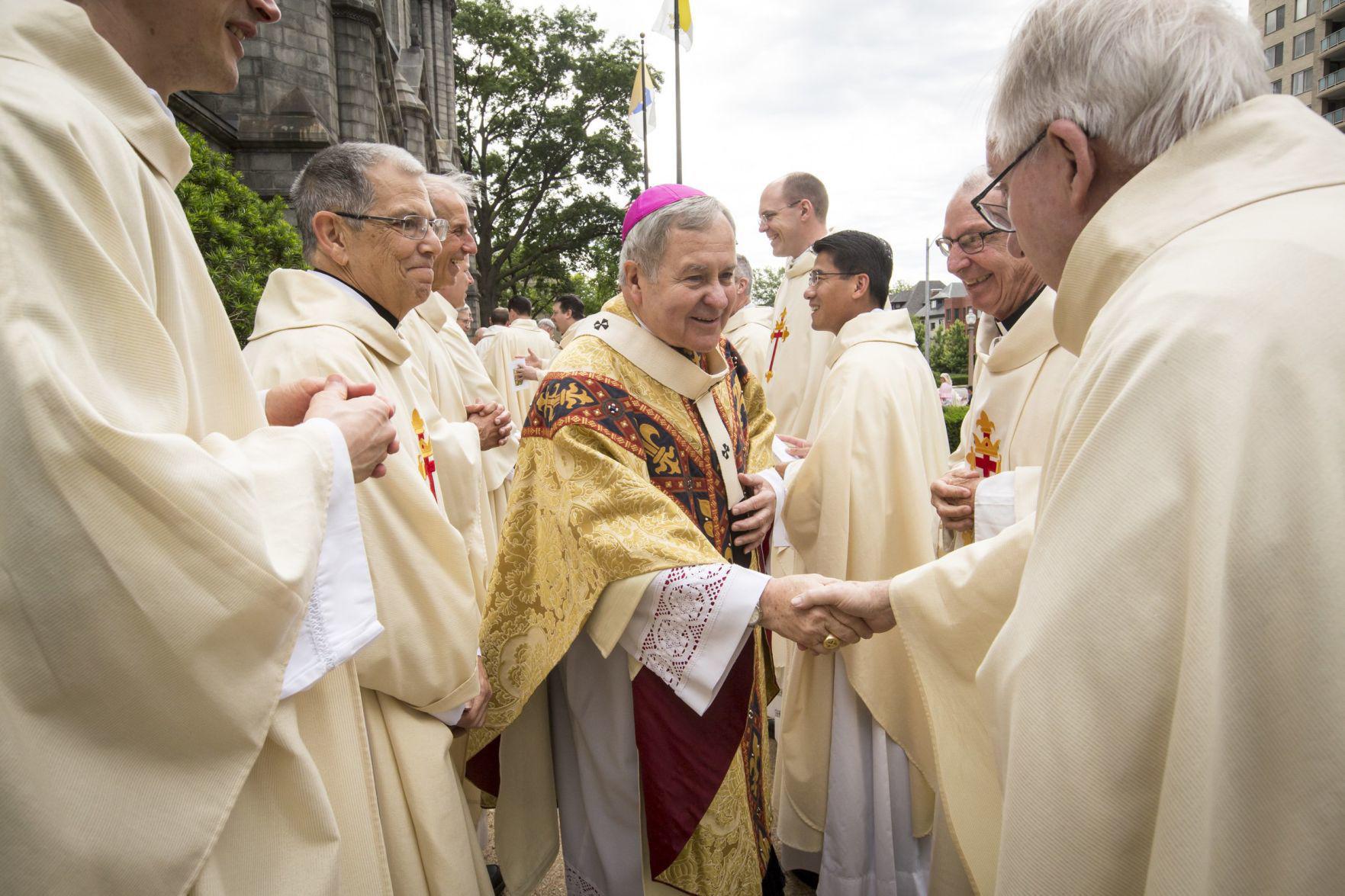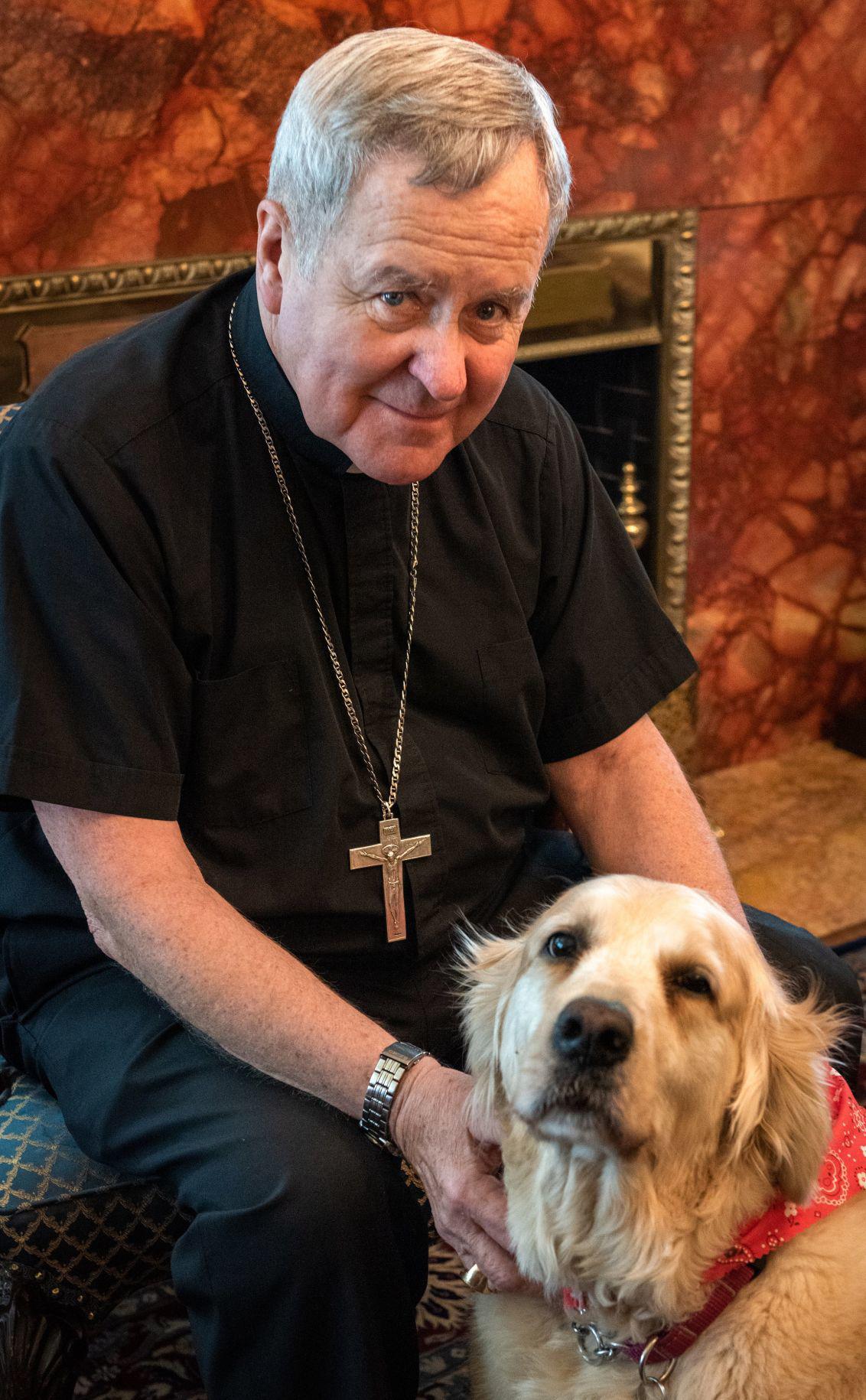|
After a decade leading St. Louis Catholics, Archbishop Robert Carlson prepares to step down
By Jesse Bogan, Nassim Benchaabane And Erin Heffernan
On the bad days, when St. Louis Archbishop Robert Carlson wished he was doing something else, his mind drifted to the thought of raising golden retrievers for a living. “Dogs don’t talk back,” he said. The four dogs he showed up with here in 2009 have since died. Now, he has a Missouri dog, Maggie, who will follow him into retirement. “I don’t want to go to committee meetings,” he said. Carlson, leader of the largest faith group in the region, must submit a resignation letter to Pope Francis on June 30. He’s turning 75, mandatory retirement age for the powerful position. It’s unclear when his letter will be accepted — days, months, years — but his flock of 500,000 Roman Catholics will be anxious to know his replacement. Many others who work at Catholic institutions or are served by them will likely be affected by the leadership change. “Any name that I would suggest would be the kiss of death,” Carlson said. “In fact, the nuncio said, ‘Who do you think should come?’ I said, ‘Oh, archbishop, you and I have been archbishops long enough to know that’s not how this works.’” Whomever it is, Carlson said his successor will inherit a large, generous Catholic community, yet one that’s shrinking and struggling to evangelize, untangle racism and offer affordable schools that more people want to be a part of. He expects to release a list of priests with credible allegations of abuse before his departure, a long-awaited announcement that may influence his legacy as much as the packed seminary. Bishops, who are like regional chief executives of the global church, are supposed to follow the same guidelines. Like the leader of any household, it’s the manner in which they do it that sets the tone for how and what work gets done. By most accounts, Carlson has been a quiet leader, known to listen to others and crack the occasional joke. “He isn’t the Lone Ranger,” said Sister Carleen Reck, a retired Catholic educator and former director of Criminal Justice Ministry. “His low-key approach has been good for the archdiocese at this time.” The Rev. Lawrence Biondi, retired president of St. Louis University, said Carlson came to the helm after “some impasses” between the university and two predecessor archbishops on issues such as coed residence halls, the selling of its hospital, and Jesuit teachings. “Archbishop Carlson came and it was a breath of fresh air and a new spirit of hope, a spirit of cooperation rather than separation and obstruction,” Biondi said. Carlson recalled that he made an appointment early on to have lunch with Biondi. By the end of the meeting, he said, they shared cellphone numbers and found a mutual love of dogs. “It was the largest institution in the archdiocese and we weren’t getting along,” Carlson said. “That gives bad witness.” Carlson, a Minnesota native, was ordained in 1970 and quickly rose to auxiliary bishop at the Archdiocese of St. Paul and Minneapolis. Then he did stints as bishop in Sioux Falls, S.D., and Saginaw, Mich. He brought leaders with him from past posts. “I’ve always considered myself a parish priest because if you forget that, you lose contact with the people,” he said. He was unheard of in St. Louis compared to his predecessor, Cardinal Raymond Burke. And still is. Settling into St. Louis, Burke famously said he would deny Holy Communion — what Catholics are taught to believe is the body and blood of Christ — to then-presidential hopeful Sen. John Kerry for his stance on abortion. Burke grabbed another big headline when he resigned from the board of Cardinal Glennon Children’s Medical Center Foundation over the appearance of singer Sheryl Crow at a benefit concert because of her support for embryonic stem cell research. Pope Benedict XVI elevated Burke from St. Louis to head the Vatican’s high court. Burke and Carlson both specialized in church law. “He’s extremely talented. A lot smarter than me,” Carlson said. “I think I have gifts that he doesn’t have. I think I can talk to people a lot easier. That’s not threatening to me. I think that he just was more formal.” Carlson has made his share of headlines, though. He vowed to appeal to the U.S. Supreme Court a court case ruling that found St. Stanislaus Kostka Catholic Church property ultimately belonged to its Polish congregation in north St. Louis, not the archdiocese, a controversial issue that preceded Carlson. Under his leadership, the archdiocese supported the firing of a popular music teacher at St. Ann Catholic School in north St. Louis County when it was publicized that the teacher planned to marry his male partner of 20 years. Carlson testified in a deposition in 2014 that he didn’t know it was a crime for an adult to have sex with a child in the 1980s, a comment the archdiocese said was taken out of context. In another statement covered by the New York Times, Carlson issued a letter calling on parishes to consider alternatives to Girl Scouts, saying the organization had highlighted role models on social media who conflict with Catholic values and supported organizations that promote contraception and abortion rights. “We must stop and ask ourselves — is Girl Scouts concerned with the total well-being of our young women? Does it do a good job forming the spiritual, emotional, and personal well-being of Catholic girls?” Carlson wrote.
A dwindling flock
The modern story of the Archdiocese of St. Louis is one of decline. The former “Rome of the West” has shrunk to include St. Louis and 10 eastern Missouri counties. But the boundary still holds one of the largest Catholic communities in the country, considering churches, hospitals, schools, universities and religious orders such as Dominicans and the School Sisters of Notre Dame. Congregants alone put $110 million in the offering plate in 2018, up from $105 million in 2009. That doesn’t include fundraising events, such as an additional $110 million pledged for the Beyond Sunday Campaign, which Carlson created to enhance Catholic schools. Still, his successor will need to weigh closing churches and schools. Over the last decade, baptisms for children younger than six fell 20% from 5,711 to 4,564 a year. Catholic school enrollment, in kindergarten through high school, fell 25% from 43,086 to 32,487. The number of schools dropped 14% from 152 to 131, and parishes fell 3% from 185 to 179. Much like municipalities that don’t want to give up their power and identities, parishes want to have their own priest and school, despite fewer congregants. Carlson said Holy Cross Academy, where several parishes support a school system in south St. Louis County, was a “powerful example” of working better together. The flock has been moving west from the riverfront for generations. Today, the three largest parishes are all in St. Charles County: St. Joseph in Cottleville, 18,060 parishioners; Immaculate Conception in Dardenne Prairie, 14,680 parishioners; and Assumption in O’Fallon, 9,885 parishioners. Those three churches are served by nine priests, compared to 31 priests who lead 34,000 congregants spread across in 26 south city parishes. The small churches have better attendance rates to Sunday services. Overall, about a fourth of Catholics go to church each week in the archdiocese. Carlson said evangelization is his biggest concern. He said some short-term attempts to reach new people and those who have left the church have worked, but not in the long run. “What can we do not just to get them through the door, but to have a relationship with Jesus Christ?” he said. He said Catholic schools are too expensive and need to attract more people. He said racism continues to be a challenge across the spectrum of services. Carlson created the Peace and Justice Commission following the 2014 police shooting of Michael Brown in Ferguson. He asked priests to preach on the topic of racism after being appalled by what he heard at a listening session, when about 20 people shared recent experiences in Catholic parishes, schools and institutions. “I’ve gotten not all but many of the priests to preach about racism,” he said. Why not all? “In this day and age, you win by getting people on the team,” he said. “You win by inviting people to do things. Thundering from on high, I don’t think it works.”
Refocused seminary
Most St. Louis priests are educated at Kenrick-Glennon Seminary, a 44-acre spread in Shrewsbury that has been a focus for Carlson. “I want them to understand that they are here to serve,” he said of future priests. “I want them to respect where the people are at and don’t demand that they have to be where you think they should be at. But if you are right, come up with a process to help them grow.” Carlson saw through to completion a capital campaign started by Burke that raised $61 million for the seminary, built in 1931. The funds increased the school’s endowment and were used to gut the aging building and make a new library and a recreation center with an exercise room. Carlson reshaped the curriculum, shifting focus from academic lessons to add more practical instruction on life in a parish. Where a seminarian once would’ve been assigned a 10-page term paper, today he might prepare a lesson on how to teach a concept to a Sunday school class. Carlson reinstituted a policy requiring a year of living and working at a parish church before men become priests in the archdiocese. Most seminarians had only been spending summers and weekends in a parish before ordination. “People are a lot different than books,” said the Rev. James Mason, the president-rector at Kenrick-Glennon and a former prosecutor in Minneapolis. “We want these men to see the messiness of a parish, the tension between how things should be and how they are. We don’t want them to use the seminary as a cocoon.” In the coursework, the seminary made once-elective practical classes like grief counseling and marriage counseling mandatory for all seminarians during Carlson’s tenure, said academic dean Ed Hogan. The coursework at Kenrick-Glennon now starts with the more academic classes and moves to the practical. “It’s like medical school,” Hogan said. “You learn the theory then you put it into practice.” Preaching also became a new focus. On a recent afternoon, the Rev. George Staley, a recent Kenrick-Glennon graduate, stood in a seminary classroom near an empty casket that students use to practice saying a funeral. Seminarians now record themselves preaching for hypothetical events — a wedding, a funeral, a holiday — and watch the film back for feedback, Staley said. “It can be hard to watch,” he said. “But it’s all about making us better at connecting with people.” The other biggest change over the last decade, according to Staley: It’s a lot more crowded. Next year Kenrick is expected to have its largest enrollment in at least 33 years — 140 seminarians, up from 115 when Carlson was installed as archbishop. That will put the seminary at near maximum capacity, said Mason, the president-rector. Mason said the increased enrollment is because more dioceses that don’t have their own seminary in Texas, Kansas and Oklahoma, among others, have opted to send prospective priests to Kenrick-Glennon. The number of seminarians for the Archdiocese of St. Louis at Kenrick has remained between about 40 and 50 during Carlson’s tenure. Despite a full seminary, and one of the highest rates of priests per person in the country, the total number of St. Louis priests is still shrinking, mirroring national trends. There are 322 priests today, down from 357 in 2009. Carlson said some other areas of the country rely more on other church members to fill roles while the number of priests decline. During his time in Saginaw, Carlson said 27 religious sisters worked as parish life coordinators, some who shared their perspectives on Scripture readings after Mass was celebrated by a priest. There are a handful of similar positions in St. Louis, as well as some deacons who can perform many of the same duties of a priest. “We have others who are interested when the need arises, and it will sooner than later,” Carlson said. “We have to find ways to get everybody involved.”
Wrestling with clergy sex abuse
Carlson was bishop of Sioux Falls in 2002, when a groundbreaking investigation by the Boston Globe newspaper uncovered widespread abuse and cover-ups by church officials there. In response, he invited the South Dakota attorney general to review diocese files, an action he would take again in 2018 as Archbishop in St. Louis after an explosive Pennsylvania grand jury report on clergy abuse renewed focus on the issue. He leaves the archdiocese with a program to safeguard children that includes training for clergy, staff and parents, background checks, parish audits, and a rule prohibiting adults from working alone with children. When someone comes forward with an allegation of sexual abuse, state authorities are notified and priests are removed until an investigation is completed. A lay board reviews allegations of sex abuse. But to advocates of victims of clergy abuse, the actions were too little, too late. They say that Carlson’s career record on handling sexual abuse will be no different from other church officials who, if they did not cover up abuse by priests, looked the other way. “He has failed to protect children and tell the truth too many times,” said Jeff Anderson, a Minneapolis attorney specializing in sex abuse cases who has taken Carlson’s deposition six times in connection with lawsuits alleging abuse by priests. Anderson also combed through dozens of files on priests in the Archdiocese of St. Paul and Minneapolis credibly accused of sexual abuse. Many of the files originated when Carlson was chancellor, vicar general and auxiliary bishop in St. Paul-Minneapolis from the late 1970s to 1994 and a primary investigator into clergy That past resurfaced in 2014 during a deposition Anderson took of Carlson in connection with a priest abuse case in the Twin Cities in 1984. Carlson said he was unsure while he was auxiliary bishop in the ’80s if it was a crime for an adult to engage in sex with a child. “I’m not sure whether I knew it was a crime or not,” he testified. “I understand today it’s a crime.” He testified that he never reported an abuse allegation to police. He also claimed 193 times in the deposition that he was unable to remember answers to questions Anderson posed for details on alleged sex abuse cases. Court documents indicated he had clear knowledge that sexual abuse was a crime when discussing incidents with church officials in Minnesota. Carlson’s statements in the deposition triggered an outcry among people frustrated with a lack of transparency in the church. The archdiocese said Carlson was “referring to the fact that he did not know the year clergy became mandatory reporters of suspected child abuse.” Minnesota law made clergy mandatory reporters beginning in 1988. The explosive Boston Globe report in 2002 brought into relief the extent of the sex abuse scandal in the Roman Catholic Church. Before then, Carlson has said, the church did not fully realize the seriousness of the problem. “All I can say is, surely since 2002, I never looked the other way,” he told the Post-Dispatch. Carlson said he did the best he could in St. Paul-Minneapolis to report findings from abuse allegations to his church superiors. “I suppose I could have done more, but I thought I was doing the right thing by telling the archbishop,” he said. Carlson encouraged parents in one case to call police because he became frustrated with the archdiocese sending priests accused of abuse to a psychologist or psychiatrist until they were deemed fit to go back to work, he said. Carlson says he does not know what happened in South Dakota after he invited the attorney general to review diocese records. In Missouri, Attorney General Eric Schmitt has yet to reveal any major findings from his office’s review. Advocates are awaiting results. They’re asking Carlson to fulfill a promise: identifying all priests in archdiocese records with credible allegations of sexual abuse. Three dioceses in the bi-state area, as well as a Jesuit province based in St. Louis, have published such lists since the Pennsylvania grand jury report. In 2015, a court filing in a sex abuse case revealed a matrix of 240 complaints against 115 priests and other church employees in the Archdiocese of St. Louis over a 20-year period ending in 2003. The filing was closed to the public; it did not reveal names and included few details. Carlson hired former FBI and police investigators to review diocesan records and compile a list of credibly accused priests, with the aim of making the list public once the archdiocese is sure it is thorough and accurate. He won’t see the investigators’ work until the findings are reviewed by a committee of lay people, he said. Carlson said he wants to make sure the list is complete before release, which he expects will happen before he retires.
Low-key retirement plans
Carlson, a bladder cancer survivor with Type 2 diabetes, was recently diagnosed with an irregular heartbeat. He said he’s lost a lot of weight on purpose through a Mediterranean diet. He’s looking forward to retirement in Florida. Maybe he’ll go to South Dakota to pheasant hunt in the fall, perhaps St. Louis in the spring for confirmations. He’d also like to lead religious retreats. “That’s what I enjoy,” he said. He wants to see more friends and family, as well as squirrel away by himself to read, write and pray. “I’ve been a bishop a long time,” he said. “It’s time to make sure I spend more time with God, and more time with God’s people.” Contact: jbogan@post-dispatch.com
|
.
Any original material on these pages is copyright © BishopAccountability.org 2004. Reproduce freely with attribution.
